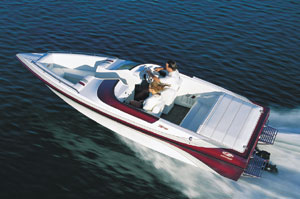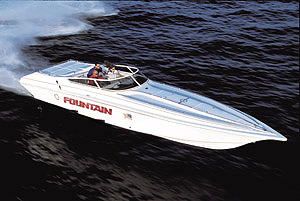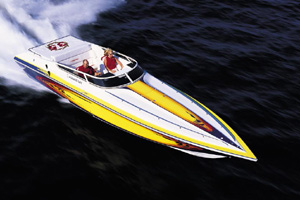Lightning 23XS: Performance Test
Lightning 23XS: Where custom quality and a low cost meet.
January 27, 2002
When it comes to boats, the faster the better. What's more, if yours qualifies as a custom job, with jazzy graphics, slick upholstery and a low-slung profile, you're even better off. But what if someone told you that you could get a 23-footer with respectable performance and eye-catching custom touches on a dual-axle trailer for less than 35 grand?
Chances are you wouldn't believe them, but it's true.
Lightning's 23XS is all of the above and more. During our Parker, Ariz., round of Performance Trials, we had the chance to sample this intelligent combination of performance, attitude and value. Equipped with optional billet swim platforms, an hour meter and a glove box, the 23'-long 7'8"-wide 23XS rang in at $35,879. Strip away those options you still have a trick boat on a trailer for $34,900.
Performance
The hull design was straightforward and simple, with 20 degrees of deadrise, four strakes and a delta pad at the transom. No afterplanes, notches or steps here. Bolted to the flat transom was a Bravo One drive with a 1.5:1 gear set, which spun a stainless-steel 15 1/4" x 22" Bravo One propeller. Under the engine hatch, a fuel-injected MerCruiser 7.4-liter big-block provided 310 ponies.
With that combination, the 23XS reached a top speed of 60.5 mph at 4,600 rpm on a glassy section of the Colorado River. Top speed aside, the 23XS performed admirably given its mild power. Acceleration from 0 to 5 seconds clicked 31 mph on the radar gun and 50 mph in 10 seconds. Five more seconds on the stopwatch brought 56 mph. It's also interesting to note that the boat was on plane in 3.1 seconds, which is on par with some inboard ski boats we've tested.
Midrange acceleration produced times of 4.4 seconds to go from 30 to 50 mph and 5 seconds to go from 30 to 50 mph. Again, impressive given the 23's mild power plant.
At those speeds, the simple hull design allowed the boat to cleave through slalom turns with ease. No surprises at 20, 30 or 40 mph or when our lead tester yanked the throttle back. Tracking was impressive, as was low-end throttle response. As speeds increased, however, throttle response waned.
During our Performance Trials, which are filled with boats with loud graphics, and often with louder exhaust, the 23XS marked a refreshing change. At speed on glassy water, about the only sound was the water splashing out from beneath the hull.
Workmanship
Upon inspecting the hull, our test team came away pleased, giving the Lightning the highest marks for its gelcoat application and luster, and good marks for the mold work, which displayed a few minor waves. Lightning obviously installed the rubrail with care, because it was devoid of obvious waves or undulations from bow to stern.
Underneath the glossy gelcoat lay a lamination schedule that consisted of biaxial and quadraxial fiberglass fabrics, vinylester resins, and Coremat to reduce unsightly print-through. At the heart of it all was a Microlam and marine-grade-plywood stringer system.

Lightning added some nice touches to the engine bay, such as upholstering the underside of the hatch with a tasteful gray matting and providing padded coaming panels with vinyl pouches to port and starboard.
Lightning added some nice touches to the engine bay, such as upholstering the underside of the hatch with a tasteful gray matting and providing padded coaming panels with vinyl pouches to port and starboard. With similar attention to detail, assemblers rigged all wiring and lines using black nylon clamps. To keep the inside of the transom wall clean and uncluttered, Lightning mounted the drive-trim pump low and inside toward the MerCruiser motor.
Interior
As you might expect from a value-priced boat, the Lightning's interior was as simple as its hull design, yet highlighted with enough accents to let you know this is still a custom boat.
For example, bow seats were swathed in simple white marine-grade vinyl with a Lightning logo stitched into the forward-most bolster, and with basic piping and stripes on the forward-facing backrests. Stowage beneath the bow seats complemented the cavernous open spaces beneath the driver's and co-pilot's legs and the space beneath the rear bench.
Built into the port-side dash was an optional glove box. To starboard, the 23XS came with just enough instrumentation to get the job done. One minor setback was that the steering wheel partially blocked the tach and speedo, which likely could be corrected by moving them to the outside corners of the dash.
At the center, the nontilt steering wheel was placed appropriately for drivers of all heights and the Mercury Quicksilver 3000 throttle—though not our first choice for controls—was located in just the right spot.
Skiing
Our ski-test team noted that the boat had ample takeoff power, but lacked such skiing necessities as an observer's mirror and a genuinely usable swim platform. During ski drills, our lead skiing tester marked the Lightning down a bit, noting that the wakes were a bit large for his tastes, but then, this is a 23' boat that weighs 3,200 pounds.
That weight was a blessing when it came time for wakeboarding, creating a deep impression in the water that left a lasting impression on our wakeboard tester. According to the log books, wakes were clean and well shaped for a stern-driven 23-footer.
Overall
If you and your buddy both show up at the ramp with a new 60-mph custom boat, who's going to look smarter, the guy who spent $50,000 or the guy who spent $35,000? That answer should be easy.
Test Results
Hull and Propulsion Information
| Deadrise at transom | 20 degrees |
| Centerline | 23' |
| Beam | 7'8" |
| Hull weight | 3,200 pounds |
| Engine MerCruiser | 7.4-liter MPI |
| Cylinder type | V-8 |
| Cubic-inch displacement/horsepower | 454/310 |
| Lower-unit gear ratio | 1.5:1 |
| Propeller | Mercury Bravo One 15 1/4" x 22" |
Pricing
| Base retail | $34,900 |
| Price as tested | $35,879 |
Standard Equipment
MerCruiser 7.4-liter MPI, swim steps, ski locker, billet package, full instrumentation, cupholders, custom-matched interior, tandem trailer.
Options on Test Boat
Billet swim step upgrade ($600), glove box ($290), hour meter ($89).
Acceleration
| 5 seconds | 21 mph |
| 10 seconds | 31 mph |
| 15 seconds | 50 mph |
| 20 seconds | 56 mph |
Midrange Acceleration
| 20-40 mph | 4.4 seconds |
| 30-50 mph | 5 seconds |
Rpm vs. Mph
| 1000 | 8 mph |
| 1500 | 10 mph |
| 2000 | 19 mph |
| 2500 | 33 mph |
| 3000 | 41 mph |
| 3500 | 48 mph |
| 4000 | 53 mph |
| 4500 | 59 mph |
Top Speed
| Speedometer | 65 mph at 4600 rpm |
| Radar | 61 mph at 4600 rpm |
| Nordskog Performance Products GPS | 59.5 mph at 4600 rpm |
Planing
| Time to plane | 3.1 seconds |
| Minimum planing speed | 19 mph |
Fuel Economy
| At 35 mph | 4.2 |
| At 45 mph | 3.5 |
| At 55 mph | 2.5 |
| At WOT | 2.6 |
| Fuel capacity | 50 gallons |
Manufacturer
Lightning Powerboats
Dept. PB
14423 Bond Court
El Cajon, CA 92021
(619) 443-1100
www.ultraboats.com.















